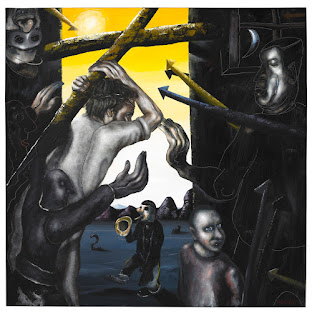The Preacher’s Study
Paschal Triduum - Maundy Thursday
John W.B. Hill
Exodus
12:1-4, (5-10), 11-14;
Psalm
116:1-2, 12-19;
1
Corinthians 11:23-26;
John
13:1-17, 31b-35
The Maundy Thursday liturgy marks the beginning of The
Passover of the Lord, the Great Three Days (each ‘day’ beginning at twilight —
see Exodus 12:6).
At the beginning of the first ‘day’ (Thursday evening), we hear the story of the slaughter
of the Passover lambs and the institution of the meal by which the Exodus would
be remembered; then we celebrate our union with the Lamb of God who instituted
a new meal of remembrance by which the New Exodus would be remembered.
At the beginning of the third ‘day’ (Saturday evening) we hear the story of the crossing of
the Red Sea; then we celebrate our crossing over from death to new life in the
Paschal Mystery of Jesus. (In between
lies the great sabbath, the day Jesus rested from all the work that he had done
in new creation — see Genesis 2:2; John
5:16-17; 19:31-33).
When we preach on Maundy Thursday, therefore, we need
to acknowledge this relationship between the historical prototype of the
world’s creation and redemption and its final realization in the work of
Christ. We are neither reconstructing
the Last Supper, nor experiencing a Jewish Passover Seder. We are beginning
our three-day celebration of the Passover of the Lord, God’s marvellous
re-creation and redemption of the world through the life, death and
resurrection of his Son. This has been
the goal of our Lenten pilgrimage; the hour has come (John 13:1)! The results of
this New Exodus will be the re-birth of the royal priesthood, the holy nation (1 Peter 2:9; see Exodus 19:6), but only
as we come to terms with the Paschal Mystery — Jesus’ rejection and death, and
his resurrection and ascension to glory.
One of the themes in the appointed gospel text for
this night is all that Jesus now knew and understood (John 13:1, 3) and all that his disciples did not yet know or
understand (John 13:7). We might compare their situation with that of
the escaping Hebrews as they approached the Red Sea (Exodus 14:10-14). But Jesus
provides for them and us, as God had provided for ancient Israel, a ritual
practice through which they and we would come to understand: sharing bread and
wine in memory of him, and washing one another’s feet.
In the ancient Church, foot-washing became the ritual
by which the Lenten journey of return of those who had betrayed the Lord, or
lost their way as disciples, was completed in a closing act of reconciliation,
after which those making this return journey could celebrate the Passover of
the Lord together with all the faithful.
In the contemporary baptismal rite used by Anglicans in North America,
the baptismal covenant is expanded beyond the baptismal creed with some
additional questions, the second of which is “Will you persevere in resisting
evil and, whenever you fall into sin, repent and return to the Lord?” The Church never knowingly re-baptizes
anyone, not even if they have wandered away from the covenant of their baptism;
as Jesus says, “One who has washed does not need to bathe, except for the
feet...” Our feet are the symbols of our
walk, of the direction of our life, and when we stray we can be renewed in the
covenant of our baptism through such an act of mutual service. For we were not baptized into a merely
individual following of the way of Jesus, but into a royal priesthood, a holy
nation. It is through our love of, and
service to, one another that we become the revelation of the Paschal Mystery to
the world. “By this everyone will know
that you are my disciples, if you have love for one another.”
John
Hill is a presbyter in the Anglican Church of Canada (ACC). A member of APLM
Council, John served as chair for the Primate’s Task Force on Hospitality,
Christian Initiation and Discipleship Formation in the ACC. The work of this
group led to the development of ‘Becoming the Story We
Tell.’
Stanley Spencer, Last Supper (1920)
Nadine Rippelmeyer, The Footwashing








